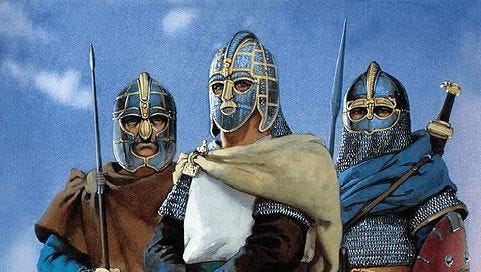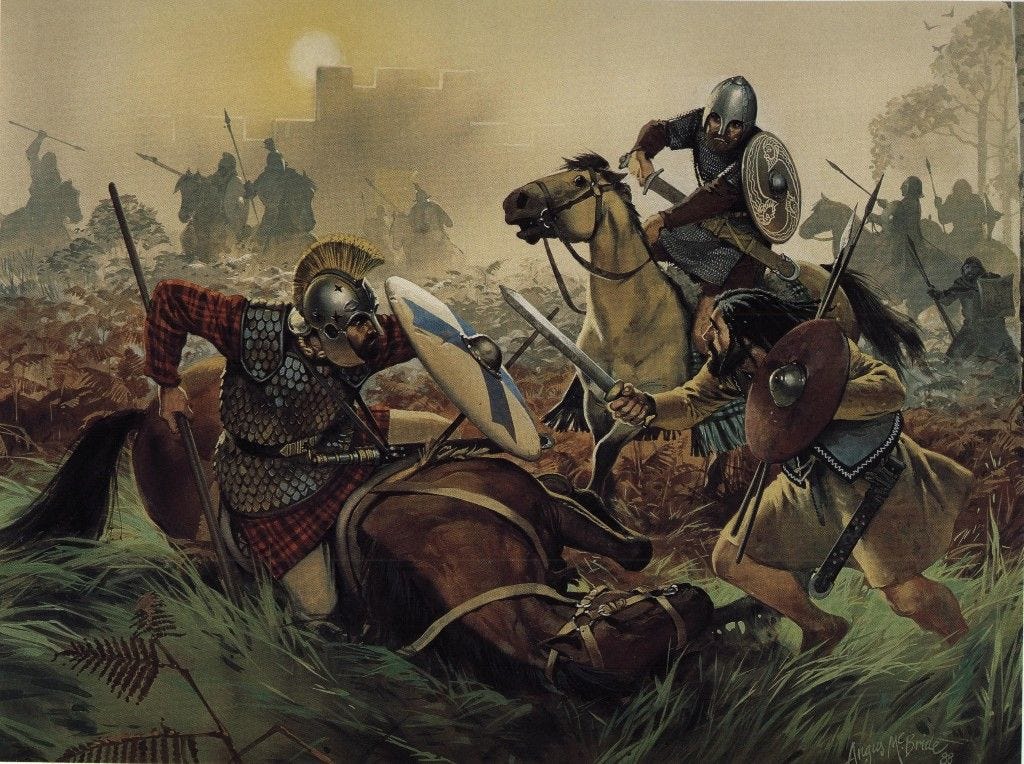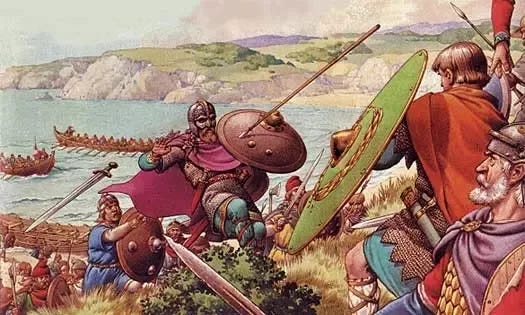Can You Hear the Drums?
Hello Dear Reader,
In the third edition of Flint and Steal we come to one of history’s most reverberating events. The reverberation of this event would not be felt for some time, but it would shape the world we live in today by no small measure. However, we will not be focusing on the reverberation but rather that first pebble that led to the tidal wave. I am talking of a movement of man. Many of them. So many that some may even use the past tense: men (and women). I am talking about the Anglo-Saxons and more specifically how they would invade the British Isles. Why is this important? Because this isn’t just another regional invasion, this is the story of how an ancient Germanic tribe would one day found the country of England. So come, take a seat around my fire and let’s begin, the drums of war are beating, and we do not have much time.
What
First and foremost, this invasion is something that needs to be put in some severe context. This is due to the invasion revolving around a number of events in the world of late antiquity and we should make note of said events. Let’s talk about the Romans. Now, before you leave just hear me out. I know that the Roman Empire has been mentioned in every publication so far, but they were quite the force in their day. Numerous countries and peoples, in this time, needed to deal with them, peacefully or otherwise. Whatever manner they “dealt” with them was up to those peoples, but we will need to deal with them too if we are to learn something about Greater Britain today. The Romans will be mentioned at various times during this publication but just know that this invasion is during a time when Rome is failing and is soon to be no more.
Who
Before we go any further, I also need to make something else very clear. The Anglo-Saxons are NOT the English, or at least they would not be for some time. The Anglo-Saxons are also NOT the Vikings. The Viking incursions came into England many hundred years later, although there are many similarities and ancestry between the two peoples. The name Anglo-Saxon can also be misleading. The people that invaded England in the early centuries AD were the Angles, Saxons, and Jutes and these tribes of Germanic peoples came from present day Northern Germany and Denmark. This is an important distinction to make because when the term “Anglo-Saxon” is used, it really means a combination of these tribes and not just one people (although many people, including myself, may argue that they will become one people when migrating).
Also, take note of the short sword on the belt on the warrior on the right. This is a seax. The seax is a type of single-edged knife or sword that originated in early medieval Europe, particularly among the Germanic tribes. It was a versatile weapon used for both combat and everyday tasks, such as cutting wood or preparing food. The seax typically had a blade that ranged in length from 3 to 32 inches and a distinctive shape with a curved cutting edge and a straight back. It was worn in a scabbard attached to a belt and was a common weapon among warriors during the Migration Period and Viking Age.
When
The timeframe of this invasion comes at a difficult time in world history. Perhaps difficult is the wrong word. Maybe the world was simply going through a time of change. In the years 400 - 500 AD, these Germanic tribes would leave their home on the main continent of Europe, make their way across the English Straight (though it was not called that at the time), and make a new home in the British Isles. It sounds so simple, what could go wrong? Well, dear reader, these are not the days of citizenship requirements, filing fees, and EU Blue Cards. These are the days of attrition. See, there was already a people in the British Isles, and they were primarily all Celts. These Celts were primarily made up of the Picts and the Britons. Now there was a small population of Romans in Britain, but Rome’s strength was failing by the time the Anglo-Saxons had begun to move. They had already started to leave in 383 AD and were nearly all gone by 410 AD. If you were a Celt that had gone through years of fighting the Roman Empire, it looked as if you had finally achieved independence. However, they could not have been more wrong. Rome’s exodus from the Isles left somewhat of a power vacuum in the area. The Celts, or the Celtic Britons, at the time of the Anglo-Saxon Invasion, had found a common enemy in the Romans but when they left, they no longer had anything to unite them. This was different than the Anglo-Saxons who, even though they were made up of different Germanic tribes (Angles, Saxons, and some Jutes), they became one people with one purpose when crossing the sea. I believe they formed something similar to a national identity and were able to succeed as a group. Now this speculation regarding a national identity would become much more important during the later invasions rather than the beginning migrations. Please allow me to explain, as I have chosen the words invasion and migration very carefully.
Now, human beings have been migrating all around this planet since the beginning of recorded history and even farther before then. Initially, the beginning movements of the Anglo-Saxons were less violent than it would become. However, by the time 500 AD, there were a rather large number of Anglo-Saxons coming to Britain and the Britons felt as if they were being invaded. This led to an abundance of bloodshed on both sides. If the Anglo-Saxons had not forward positioned their people on the Island and found a common identity, I believe they would have been expelled (at the very least) or simply wiped out.
Where and Why
Well, dear reader, I hope I haven’t spoiled the plot too well. Something rather interesting to note, and then speculate, would be the landing sites of these Germanic forces. As we can see from the map below, these people migrated to the Southern Shores of present-day England coming in during that 100-year timeframe between 400 AD and 500 AD. The time frame is pretty straightforward. However, I would argue that the routes are not. In this map we can see a red-dotted line roughly detailing the main sphere of roman influence on the island. Note how the Germanic people migrate to this area as well. They come to the Romanized parts of Britain. Why do they do so?
Now certainly, the Roman parts of Britain would have been more “industrialized” or “developed” that the rest of the main island, but how would the Anglo-Saxons have known that? What is even stranger is that the parts of Germany and Denmark that these people came from is just outside the extent of the Roman Empire, even at its height in 117 AD (seen below). So, if these people had never been Roman subjects but they came to the Roman hub of the country, how would they know where to go and why?
Dear reader, I believe this migration to be another example of the ancient world being a lot more interconnected that we previously thought. I do hope you are beginning to see an emerging theme arising in these publications. I also believe that we should look at the specific places the Anglo-Saxons come from, and I am not talking about modern day Germany again. I am talking of their proximity to the sea. They have prime, appreciating, sea-side real estate and I am sure that you know, just as I do, that the easiest way for people to trade and travel back in the day was over water. Now the Saxons knew this, and they knew it very well. There are records of Saxon pirates raiding shipping lanes and gaining much loot and plunder for themselves and their kin. These Saxon sea raiders (I told you there would be additional Viking similarities) became so proficient in their trade that the Franks (the people to their south) took note and decided to join them. Unfortunately for them, when the Franks and Saxons became so proficient in sea raiding, the Romans eventually had a responsibility to take note and put an end to the harassment of Britain’s shores. So, at around 280 AD, the Roman commander, Carausius was put under orders to stop these raids and stop them he did. Unfortunately for the Romans, this would be the last time they stopped the Saxons. However, the idea of Britain and the plunder it held would never leave Anglo-Saxon minds.
Something also extremely interesting is that there are recorded hirings of Anglo-Saxons warriors by the Romans to help them keep the peace in Britain. Let me rephrase, the Roman Empire hired Anglo-Saxon mercenaries to act as soldiers in the British Isles. Now, it can be imaged that these mercenaries would have gone back and forth and told their families and friends all about their adventures and what they experienced there. They would also have told them about the climate. In Britain during the migrations, it was around 2 degrees (Fahrenheit) warmer than it was today. This was much warmer than Northern Germany and Southern Denmark, which meant that farmers could grow more crops there. This meant that as a people, they could grow more food and thrive, or at least do better in Britain than in their native homes. So, in conclusion, we find that the Anglo-Saxons not only knew of Romanized Britain, but they wanted it, and they wanted all of it.
As previously mentioned, there were Anglo-Saxon migratory waves but what was not mentioned was that they were all led by different kings or leaders that would establish different kingdoms. Hengst came over in 449 AD and established Kent. Ælle came over in 477 AD and established Sussex. Finally, King Cerdic, who is said to have defeated King Arthur in battle, established a West Saxon Dynasty in a place that would become better known as Wessex. He came established his kingdom in 519 AD after defeating a force of Celtic Britons. These kingdoms would fight each other and evolve, but I cannot include the entire history of Britain in this publication, as we would be here all night. However, dear reader, we should focus on the Kingdom of Wessex because, as a student of history, I am obliged to add some emphasis on the importance of Cerdic’s line as there may be no dynasty that is most important to the entire world than the West Saxon Dynasty. This importance is well deserved as Cerdic’s Wessex would eventually become the kingdom that would unite the lands of Southern Britain into England. Yes, dear reader, England. This would not happen until 927 AD but, as someone from across the pond, I think it is simply mind-boggling how an invasion from 1500 years ago could lead to the beginning of the nation I live in today. Over the next 1000 years, nearly every corner of the world would know England and either love it or tremble at its name.
So, what can we take from this? First, we can see that this is another example of the ancient world being more organized and connected than previously thought. I mean pulling off a mass migration or invasion is no small feat. This is especially true for a force that is required to also defeat the standing armies on the island. The level or coordination to land and then fight is something that modern armies still have difficulty with. I believe that this helps prove that our ancient human ancestors had similar cognitive capacities to people today. They may just not have known as much raw knowledge as we do. Secondly, we can see that, for much of the history of the British Isles, it was not all tea and crumpets. This invasion would be only one of the many that the isles would experience over centuries of war, but it was the beginning of a nation that would touch every geopolitical structure on Earth. (I suppose that over these centuries the English would become a little tired of being invaded and may have decided to be the invader for once.)
Well, dear reader, it seems the drums no longer beat. I want you to know that I thoroughly enjoyed our time together and that you are always welcome around my fire. Stay tuned for my next publication, where we will be taking a trip South, to the glistening shores of the Mediterranean.
-Flint










